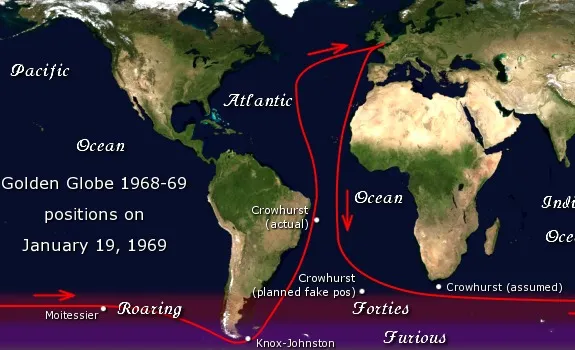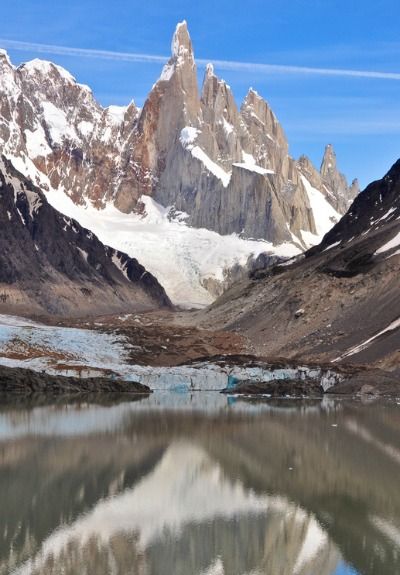Cheating Their Way to Fame: The Top 9 Adventure Travel Hoaxes
From polar exploration to summit bids to marathons, claims of heroic journeys have turned out to be tales woven with lies
/https://tf-cmsv2-smithsonianmag-media.s3.amazonaws.com/filer/20130417090124HoaxesFrederick_Cooks_1909_arctic_expedition2.jpg)
Traveling may be thrilling, exhausting, dangerous, mind-opening and, occasionally, boring. But more than anything else, going to faraway places is easier talked about than done. Thus, we find history riddled with quiet rumors and full-fledged scandals surrounding claims of heroic journeys that turned out to be tales woven with lies. Other adventurers’ claims, while not known hoaxes, have dwelt in the limbo of critical doubt for years or decades. Following is a listing of some of the best and least known of the world’s travel hoaxes.
Donald Crowhurst and the Solo Sailing Race Fraud.
In the late ’60s, Donald Crowhurst had the world believing that he was sailing around the world at a record-smashing pace—but skeptics today believe that Donald Crowhurst fictionalized nearly every mile of his 1968-69 solo voyage. The British amateur was racing against seven others in the Sunday Times Golden Globe Race, a round-the-world race that began and ended in southern England. Crowhurst was vying for the large cash prize while also hoping to generate publicity for his marine navigational hardware company.
But Crowhurst, an inexperienced sailor, had barely begun when he began to doubt he had any chance of winning—or perhaps even surviving—the global voyage. His boat began to leak, and he was falling far behind the competition. So he gave up—without telling anyone. While his competitors sailed southward to the Southern Ocean and then eastward, Crowhurst never left the Atlantic, all the while sending falsified radio reports to listeners of his progress. Perhaps by accident, Crowhurst put himself far in the lead—and, what’s more, on a course to break the world’s record for the same route. As the competition dropped out of the race one by one for various reasons, more and more eyes turned to the horizon, awaiting the appearance of Crowhurst, the heroic underdog. But Crowhurst never showed. While Robin Knox-Johnston returned to England as the race’s only finisher, Crowhurst seems to have panicked, doubtful he could pull off the fraud and terrified of the shame he would face. His boat was found adrift on July 10, 1969, in the Caribbean. Of Crowhurst himself there was not a sign. Many believe he committed suicide. His boat was towed ashore and today remains a rotting tourist attraction on the beach, on the island of Cayman Brac.

Christian Stangl and K2.
After three summers spent on K2 and not once looking down from the coveted summit, Austrian climber Christian Stangl returned to lower altitudes in August 2010 and told the world he had done it—climbed the world’s second-highest mountain in what would have been a phenomenal time of four days round-trip from the base camp. No one else reached the peak that year, and one climber died trying—but quickly, climbing experts began asking if Stangl had, either. Stangl, after all, was never seen above Camp 3, and he produced no GPS signals from the summit. He also had just one summit photo to prove his achievement—and something was funny about it; Stangl’s photo, it appeared, was taken from lower on the mountain than other existing summit shots.
Eventually, Stangl came clean, admitting his deception but explaining that he had begun to hallucinate on the mountain due to the thin air. He says he descended (after a bizarre face-off with what may have been a snow leopard) truly believing he had stood on K2′s summit. To his genuine credit, Stangl climbed K2 in a confirmed summit attempt in 2012. He sent out his coordinates signal 21 times and took a 360-panorama video sequence to prove his claim, and for this stubborn and accomplished Austrian alpinist, redemption arrived.
Frederick Cook and the Mount McKinley Hoax.
Frederick Cook almost certainly set foot in many places where previously no person had before—but the New York-born explorer is also seen as one of modern exploration’s most notorious fraudsters. He participated in three significant expeditions between 1891 and 1903, two of them into the Arctic and the latter a circumnavigation of Alaska’s Mount McKinley, also known as Denali. In 1906, he set forth on another McKinley outing, this time returning home to report that he had summited the 20,320-foot peak, which had never been climbed before. The claim stood the test of time for only three years, when the true story came spilling out: Cook had taken his summit photo on a tiny mountain 19 miles from McKinley’s peak.
Cook’s claims have since been thoroughly dissected and discredited; the descriptions he made in his journal of the landscape near the summit were found to bear little resemblance to the real mountain, and modern-day climber Bradford Washburn took it upon himself to identify every place on and around the slopes of Denali where Cook took his expedition shots. It has been determined that Cook and his small group of men never approached closer than 12 miles to the summit of Denali. So who first climbed the highest mountain in North America? Hudson Stuck, in June 1913.
Cook and the North Pole Debate. After his Mount McKinley expedition, Frederick Cook ventured farther north, into the Arctic—though just how far he went became the subject of argument, accusation and scandal. In 1909, Cook staggered home from the ice, having almost starved to death en route. He claimed he had been to the North Pole and back, which would now give him claim to two magnificent feats of exploration. Then, doubts arose about his polar voyage—for Cook could not produce evidence that he had reached the North Pole on April 22, 1908, as he had claimed.
Moreover, his two Inuit guides, Ahwelah and Etukishook, who traveled with Cook across the Arctic sea ice, later reported that, all traveling together, they had only gone several days from land across the frozen sea—not far enough to have brought them to 90 degrees north latitude. Eventually Robert Peary, who claimed to have reached the pole on April 6, 1909, was widely credited as the first explorer to reach the North Pole—though some historians today aren’t convinced Peary actually got there. It was while reviewing Cook’s account of reaching the North Pole that skeptics looked back several years, to Cook’s claimed McKinley conquest. It was eventually discredited entirely as rubbish, and Cook’s reputation as an explorer crumbled.
Eric Ryback and the Pacific Crest Trail.
Eric Ryback was just 17 when he first hiked the Appalachian Trail in 1969—and in the next three years he would walk both the Continental Divide and the Pacific Crest trails, making him the first person to complete all three of America’s great long-distance hiking trails. But when rumors emerged that the young trekker had hitchhiked and thereby circumvented parts of the Pacific Crest Trail, his claim to fame began to wilt. Ryback, who by this time had written a book—The High Adventure of Eric Ryback —about his walks, fought back. When the guidebook publisher, Wilderness Press, stated in print that Ryback had used motor transport in places along the PCT, Ryback sued for $3 million—but he withdrew the suit after Wilderness Press revealed statements from the very people who had supposedly picked up the young hiker along highways parallel to the 2,600-mile trail. The claims that Ryback “cheated” are still doubted by some—although the term “yellowblazing,” used to describe hitchhiking near trails that one had intended to be walking, has been reportedly replaced at times by a new verb: rybacking.

Oh Eun-Sun and Her Questioned Climb of Kangchenjunga.
In 2010, South Korean climber Oh Eun-Sun trudged to the top of Annapurna, thereby becoming the first woman to summit all 14 of the world’s 8,000-meter peaks—but many wonder if she really did. The question hinges on Oh’s 2009 ascent of the world’s third-highest peak, Kangchenjunga, in the Himalayas. Oh’s photographic documentation of her achievement didn’t prove she had reached the top. One image, initially portrayed as her summit shot, was unconvincing, showing the woman in mountain climbing gear surrounded by a blinding, overexposed and ambiguous landscape. Another supposed summit photo showed Oh standing on a rocky surface, whereas Kangchenjunga’s 28,169-foot summit is known to have been covered in snow at about that time. There is even evidence that some of Oh’s summit shots had been digitally doctored.
Oh’s sponsor, Black Yak mountaineering gear, assures skeptics that Oh rightly reached the summit. One of Oh’s Sherpas said the same thing—though another of the three who climbed with Oh reportedly said that the group stopped climbing more than 400 feet below the mountaintop. The Korean Alpine Federation eventually decided that not enough evidence exists to prove Oh really reached Kangchenjunga’s summit, while Elizabeth Hawley, the most respected keeper and chronicler of Himalayan records, deemed Oh’s 14-peak claim to climber’s fame as “disputed.”
Cesare Maestri and the Summit of Cerro Torre.
The peaks of the world’s mountains are so tangled with lies and controversy that one must wonder if it’s the love of climbing or the lust for glory that lures so many people into the high country. In 1959, an Italian named Cesare Maestri went to Argentina, teamed up with an Austrian named Toni Egger and attempted what had been characterized one year prior as an unclimbable mountain. They supposedly reached the top of the icy 10,262-foot pinnacle on February 3. But Egger died in an avalanche on the way down, and Maestri, upon reaching civilization and making his claim, had no evidence at all to back it up.
Almost immediately, the climb was labeled a hoax. Above a certain point on the mountain, no trace of Maestri or Egger has been found, even though Maestri claimed to have bolted parts of the route, and for decades no other climbers managed to reach the top of Cerro Torre. In 1970, Maestri returned to climb it again and, hopefully, clear the air of doubt. He used a controversial gasoline-powered bolt gun—and still he failed to reach the spire’s peak. Worst of all, perhaps, Maestri let slip a shocking trip of the tongue several years ago, when he angrily told a reporter, “What I did was the most important endeavor in the world. I did it single-handedly. But this doesn’t mean that I . . . that I reached the top, do you understand?” Did he just—? Yes, I think he did.

The Atlantic Swim That Could Not Be. The Associated Press reported in early February 2009 that American Jennifer Figge had just completed a 2,100-mile swim across the Atlantic. The story reported that Figge had begun at Cape Verde, in western Africa—on January 12. It took little time for sharp-eyed readers to flinch, do a double take and read that again: January 12 to early February. Not even 30 days. That would have been 80 miles daily—three miles per hour nonstop for a month—to complete the journey. It would turn out that Figge, who was accompanied by a boat, never even intended to swim across the width of the ocean and that poor reporting had invented the swim that couldn’t possibly be.
Rosie Ruiz, the Champion Cheater of Marathons. She finished the 1979 New York Marathon in two hours 56 minutes, a time to qualify her for an even bigger race—and in 1980, Rosie Ruiz crossed the finish line with the women’s record for the Boston Marathon. But the 23-year-old was barely sweating as she accepted the crowds’ praise. Moreover, no other competitors in the 26.2-mile run could remember seeing her in the past 150 minutes. Nor could Ruiz, when questioned, recall the details of the route. It would turn out in a shocking flood of humiliation that Ruiz had started the race, left the route, taken the subway and jumped back in for the last half-mile. Jacqueline Gareau was recognized belatedly as the real winner. Scrutiny of Ruiz’s running history led investigators to suspect that Ruiz had also used subway support in the New York Marathon.
To learn more about the deceptions of historical adventurers, read Great Exploration Hoaxes, by David Roberts, in which the author discusses the controversial explorations of ten men, including Father Louis Hennepin, who fictionalized his travels on the Mississippi, and Capt. Samuel Adams, whose scramblings in the Colorado River basin appeared later to be made up.
Planning Your Next Trip?
Explore great travel deals
Smithsonian magazine participates in affiliate link advertising programs. If you purchase an item through these links, we receive a commission.
/https://tf-cmsv2-smithsonianmag-media.s3.amazonaws.com/accounts/headshot/Off-Road-alastair-bland-240.jpg)
/https://tf-cmsv2-smithsonianmag-media.s3.amazonaws.com/accounts/headshot/Off-Road-alastair-bland-240.jpg)